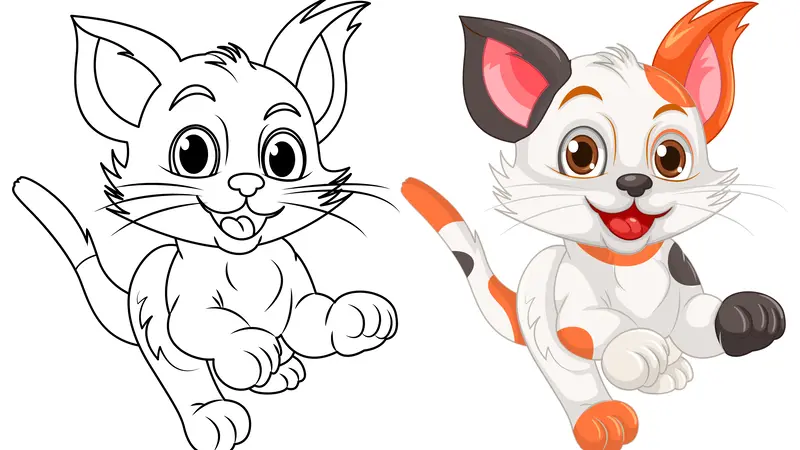Introduction to Drawing Cats
Drawing cats can be a delightful and rewarding experience for artists of all skill levels. Cats, with their graceful movements and expressive features, offer a variety of poses and expressions that can be captured on paper. This article, “Drawing:a4z_-ymtkr8= Cat,” provides tips, techniques, and insights into creating realistic and engaging cat drawings. Whether you are a beginner or an experienced artist, these guidelines will help you improve your skills and produce beautiful cat illustrations.
Tools and Materials for Drawing Cats
Essential Drawing Supplies
To start drawing cats, you will need the following tools and materials:
- Pencils: Graphite pencils in a range of hardness (HB, 2B, 4B, etc.) for sketching and shading.
- Erasers: A kneaded eraser for gentle corrections and a standard eraser for more precise adjustments.
- Paper: High-quality drawing paper or sketchbook with a smooth surface.
- Reference Images: Photographs of cats to study their anatomy and poses.
- Optional: Colored pencils, charcoal, or ink for adding color and depth to your drawings.
Preparing Your Workspace
Create a comfortable and well-lit workspace to draw. Ensure that you have enough space to spread out your materials and reference images. Good lighting is crucial for seeing fine details and maintaining accuracy in your drawings.
Understanding Cat Anatomy
Basic Structure and Proportions
Before diving into detailed drawing, it is essential to understand the basic structure and proportions of a cat. Cats have a flexible and muscular body, a distinctive head shape, and a long, tapering tail. Here are some key points to consider:
- Head: Cats have a round head with a slightly pointed muzzle. The eyes are large and positioned forward, while the ears are upright and pointed.
- Body: The body is elongated with a pronounced curve along the spine. Cats have a slender and graceful build.
- Limbs: The legs are relatively long and end in small, oval-shaped paws. The front legs are slightly shorter than the hind legs.
- Tail: The tail is long and expressive, often used to convey emotions.
Studying Reference Images
Using reference images is an excellent way to understand cat anatomy and capture accurate proportions. Observe the way cats move, sit, and interact with their environment. Pay attention to the angles, curves, and positions of different body parts.
Step-by-Step Guide to Drawing Cats
Step 1: Sketching the Basic Shapes
Start by lightly sketching the basic shapes of the cat’s body. Use circles, ovals, and lines to outline the head, body, and limbs. This initial sketch will serve as a framework for adding details.
- Head: Draw a circle for the head and a smaller oval for the muzzle.
- Body: Sketch an elongated oval for the body, slightly curved to mimic the cat’s natural posture.
- Limbs: Use straight lines to indicate the position of the legs and paws.
- Tail: Draw a long, curved line for the tail.
Step 2: Refining the Outline
Once the basic shapes are in place, refine the outline of the cat by adding more defined lines and curves. Focus on the overall shape and proportion of the body, head, and limbs.
- Head: Add the ears, eyes, and mouth. The eyes should be large and almond-shaped, and the ears should be pointed.
- Body: Smooth out the curves of the body, emphasizing the arch of the back and the position of the legs.
- Limbs: Draw the legs with more detail, adding joints and paws. Make sure the front legs are slightly shorter than the hind legs.
- Tail: Refine the shape of the tail, giving it a natural, flowing appearance.
Step 3: Adding Details
With the outline complete, start adding details to your drawing. Focus on the fur texture, facial features, and any unique markings.
- Fur: Use short, light strokes to create the appearance of fur. Vary the direction and length of the strokes to add depth and realism.
- Face: Add details to the eyes, nose, and mouth. The eyes should have a reflective quality, and the nose and mouth should be delicately defined.
- Markings: If the cat has any distinctive markings or patterns, such as stripes or spots, carefully add them to the drawing.
Step 4: Shading and Texture
Shading is crucial for adding dimension and realism to your drawing. Use different pencil grades to create a range of light and dark tones.
- Light Source: Determine the direction of the light source and shade accordingly. Areas facing the light should be lighter, while areas in shadow should be darker.
- Gradients: Use smooth, gradual shading to create transitions between light and dark areas. Blend the shading with a blending stump or tissue for a soft effect.
- Texture: Add texture to the fur by using varying pressure and pencil strokes. Focus on areas where the fur is denser or more prominent, such as around the face and paws.
Tips for Improving Your Cat Drawings
Practice Regularly
Consistent practice is key to improving your drawing skills. Set aside time each day to draw and experiment with different techniques. Challenge yourself by drawing cats in various poses and from different angles.
Study Cat Behavior
Understanding cat behavior can enhance your drawings by making them more lifelike and expressive. Observe how cats move, interact, and display emotions. Incorporate these observations into your drawings to capture the essence of a cat’s personality.
Seek Feedback
Sharing your drawings with others and seeking constructive feedback can help you identify areas for improvement. Join online art communities, attend workshops, or participate in drawing groups to connect with other artists and gain insights.
Conclusion
Drawing cats, such as the one referenced in “Drawing:a4z_-ymtkr8= Cat,” is a rewarding artistic endeavor that allows you to capture the grace and beauty of these beloved animals. Drawing:a4z_-ymtkr8= Cat by understanding cat anatomy, practicing regularly, and incorporating shading and texture techniques, you can create realistic and engaging cat drawings. Embrace the joy of drawing and continue to refine your skills to produce stunning feline illustrations.
